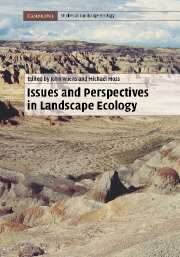Book contents
- Frontmatter
- Contents
- List of contributors
- Preface
- PART I Introductory perspectives
- PART II Theory, experiments, and models in landscape ecology
- PART III Landscape patterns
- PART IV Landscape dynamics on multiple scales
- 14 Landscape sensitivity and timescales of landscape change
- 15 The time dimension in landscape ecology: cultural soils and spatial pattern in early landscapes
- 16 The legacy of landscape history: the role of paleoecological analysis
- 17 Landscape ecology and global change
- PART V Applications of landscape ecology
- PART VI Cultural perspectives and landscape planning
- PART VII Retrospect and prospect
- Index
- Plate section
- References
16 - The legacy of landscape history: the role of paleoecological analysis
from PART IV - Landscape dynamics on multiple scales
Published online by Cambridge University Press: 20 November 2009
- Frontmatter
- Contents
- List of contributors
- Preface
- PART I Introductory perspectives
- PART II Theory, experiments, and models in landscape ecology
- PART III Landscape patterns
- PART IV Landscape dynamics on multiple scales
- 14 Landscape sensitivity and timescales of landscape change
- 15 The time dimension in landscape ecology: cultural soils and spatial pattern in early landscapes
- 16 The legacy of landscape history: the role of paleoecological analysis
- 17 Landscape ecology and global change
- PART V Applications of landscape ecology
- PART VI Cultural perspectives and landscape planning
- PART VII Retrospect and prospect
- Index
- Plate section
- References
Summary
Present-day landscape patterns are the outcome of a number of ecological, geological, climatological, and cultural processes occurring over prehistoric and historic time frames (Delcourt and Delcourt, 1991, 2004; Delcourt, 2002). The interactions of these processes change through time and are mediated by changing natural and anthropogenic disturbance regimes (Wiens et al., 1985; Delcourt and Delcourt, 1988; Turner, 1989; Russell, 1997; Foster et al., 1998a). The legacy of long-term landscape history is a lasting overprint upon both natural and cultural landscapes, as the effects of past processes leave a mark on present landscapes that may endure long into the future. This legacy has been understood for a long time in Great Britain (Rackham, 1986) and Europe (Delcourt, 1987; Birks et al., 1988) and it is now increasingly recognized in North America (Abrams, 1992; Russell, 1997; Delcourt et al., 1998; Delcourt and Delcourt, 1998, Foster et al., 1998a, 1998b).
How we view the relevant processes involved in the development of landscape patterning is conditioned by the temporal and spatial window through which we view landscape change as well as by the techniques we use to measure landscape response to physical and biological interactions (Fig. 16.1). Physical constraints on landscape development may be depicted as a nested hierarchy of controlling factors (Urban et al., 1987; Delcourt and Delcourt, 1988). For example, on a timescale of thousands of years, large and predictable changes occur in global and regional climate.
- Type
- Chapter
- Information
- Issues and Perspectives in Landscape Ecology , pp. 159 - 166Publisher: Cambridge University PressPrint publication year: 2005
References
- 1
- Cited by



